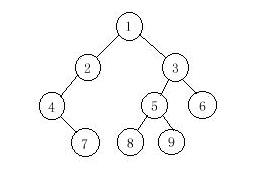http://acm.hdu.edu.cn/showproblem.php?pid=1710
Binary Tree Traversals
Time Limit: 1000/1000 MS (Java/Others) Memory Limit: 32768/32768 K (Java/Others)
Total Submission(s): 4210 Accepted Submission(s): 1908
Problem Description
A binary tree is a finite set of vertices that is either empty or consists of a root r and two disjoint binary trees called the left and right subtrees. There are three most important ways in which the vertices of a binary tree can be systematically traversed or ordered. They are preorder, inorder and postorder. Let T be a binary tree with root r and subtrees T1,T2.
In a preorder traversal of the vertices of T, we visit the root r followed by visiting the vertices of T1 in preorder, then the vertices of T2 in preorder.
In an inorder traversal of the vertices of T, we visit the vertices of T1 in inorder, then the root r, followed by the vertices of T2 in inorder.
In a postorder traversal of the vertices of T, we visit the vertices of T1 in postorder, then the vertices of T2 in postorder and finally we visit r.
Now you are given the preorder sequence and inorder sequence of a certain binary tree. Try to find out its postorder sequence.

In a preorder traversal of the vertices of T, we visit the root r followed by visiting the vertices of T1 in preorder, then the vertices of T2 in preorder.
In an inorder traversal of the vertices of T, we visit the vertices of T1 in inorder, then the root r, followed by the vertices of T2 in inorder.
In a postorder traversal of the vertices of T, we visit the vertices of T1 in postorder, then the vertices of T2 in postorder and finally we visit r.
Now you are given the preorder sequence and inorder sequence of a certain binary tree. Try to find out its postorder sequence.

Input
The input contains several test cases. The first line of each test case contains a single integer n (1<=n<=1000), the number of vertices of the binary tree. Followed by two lines, respectively indicating the preorder sequence and inorder sequence. You can assume they are always correspond to a exclusive binary tree.
Output
For each test case print a single line specifying the corresponding postorder sequence.
Sample Input
9
1 2 4 7 3 5 8 9 6
4 7 2 1 8 5 9 3 6
Sample Output
7 4 2 8 9 5 6 3 1
题解:意思很直白。给你二叉树的先序序列和中序序列,让你求后序序列。先利用先序序列和中序序列的特征递归建树,再后序遍历。
代码:
1 #include <fstream> 2 #include <iostream> 3 #include <cstdio> 4 5 using namespace std; 6 7 const int N=1005; 8 struct node{ 9 int c; 10 struct node *lch,*rch; 11 }; 12 int n,tn; 13 int pre[N],in[N]; 14 15 void createTree(int* l,int* r,int i,int j,int e,int f,node** tree); 16 void postOrder(node *p); 17 18 int main(){ 19 //freopen("D:\input.in","r",stdin); 20 //freopen("D:\output.out","w",stdout); 21 node *tree; 22 while(~scanf("%d",&n)){ 23 for(int i=0;i<n;i++) 24 scanf("%d",&pre[i]); 25 for(int i=0;i<n;i++) 26 scanf("%d",&in[i]); 27 createTree(pre,in,0,n-1,0,n-1,&tree); 28 tn=0; 29 postOrder(tree); 30 } 31 return 0; 32 } 33 void createTree(int* l,int* r,int i,int j,int e,int f,node** tree){//可以思考下这里为什么是**,可不可以用*? 34 int m; 35 (*tree)=new node; 36 (*tree)->c=l[i]; 37 m=e; 38 while(r[m]!=l[i]) m++; 39 if(m==e) (*tree)->lch=NULL; 40 else createTree(l,r,i+1,i+m-e,e,m-1,&(*tree)->lch); 41 if(m==f) (*tree)->rch=NULL; 42 else createTree(l,r,i+m-e+1,j,m+1,f,&(*tree)->rch); 43 } 44 void postOrder(node *p){ 45 if(p!=NULL){ 46 postOrder(p->lch); 47 postOrder(p->rch); 48 printf("%d",p->c); 49 if(++tn<n) printf(" "); 50 else puts(""); 51 delete p; 52 } 53 }